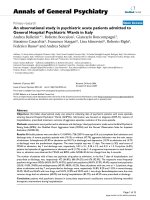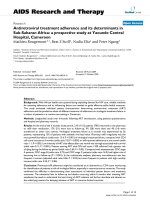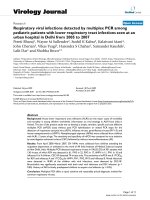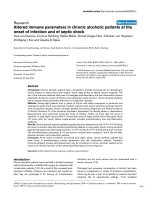Measles outbreak in pediatric oncology patients at Hue Central Hospital, Vietnam
Bạn đang xem bản rút gọn của tài liệu. Xem và tải ngay bản đầy đủ của tài liệu tại đây (3.31 MB, 5 trang )
Measles outbreak in pediatric
Bệnh viện
oncology
Trungpatients...
ương Huế
MEASLES OUTBREAK IN PEDIATRIC ONCOLOGY PATIENTS
AT HUE CENTRAL HOSPITAL, VIETNAM
Nguyen Thị Kim Hoa1, Tran Kiem Hao1, Tran Thi Kim Cuc1,
Truong Thị Kim Yen1, Nguyen Hoang Son1
ABSTRACT
Background: Measles outbreaks in immunocompromised population is a big challenge to interrupt
endemic transmission. This study aimed to investigate of measles in pediatric oncology patients and find
the reason behind the outbreak.
Methods: A descriptive and prospective study on 11 paediatric oncology patients with measles. We
collected demographic, epidemiological, and clinical data. Most of suspected measles cases were done
measles IgM test and clinical data were followed up and analysed by Medcalc software.
Results: From April 20 to July 10 in 2019, a total of 11 patients with malignancies were notified to
develop measles in Hue. Of these 11 patient with the median age of 4.0 years (range: 1 year to 9 years),
2 (18.2%) hadn’t received any dose of measles vaccine, 5 (45.5%) received 2 doses and 4 (36.4%) had
received 1 dose of measles vaccine; all patients had fever with the median fever of 39 degrees Celsius
(range: 38.5 – 39.5), the median fever duration was 7 days, 100% had cough and rash, 3 (27.3%) had
pneumonia complication, 2 (18.2%) had elevated liver transaminase level. All patients had hospital visits
or were hospitalized before measles onset, with the median time: 10 days (range: 7-24 days), all patients
were likely to exposed each other. 100% patient recovered.
Conclusions: Children with cancer is very easy to exposed measles to each other. Getting vaccinated is
the best way to prevent measles, and improved infection control was crititcal for the prevention of measles
in malignancy patients.
Key words: Children; Measles; Oncology.
I. INTRODUCTION
Measles is a viral infection that starts in the
respiratory system. It is a highly contagious, serious
disease and can be spread by direct contact, droplets,
or airbone transmission. Measles symptoms appear
7 to 14 days after contact with the virus and typically
include high fever, cough, coryza, and conjunctivitis
as well as characteristic rash. Measles still remains
a significant cause of death worldwide, despite the
availability of safe, effective vaccine[3].
There were about 110.000 global deaths related
1. Hue Central Hospital
36
to measles in 2017, most of them in children
under the age of 5, according to the World Health
Organization source.
In Vietnam, there was 1.177 confirmed measles
cases in 2018, twice as many cases as in 2017.
Most of the measles cases related to the lack of
vaccination due to parents deciding to delay
vaccination of their children. In late 2018, the
Ministry of Health launched an additional measlesrubella vaccination campaign for 4.2 million
children aged between 1 and 5 in vulnerable areas in
- Received: 24/7/2019; Revised: 31/7/2019;
- Accepted: 26/8/2019
- Corresponding author: Nguyen Thi Kim Hoa
- Email: ; Tel: 0935645836
Journal of Clinical Medicine - No. 56/2019
Hue Central Hospital
57 cities and provinces. UNICEF called on parents
to make an extra effort to consult health official
to ensure that their children’s immunization status
is up to date to protect their children against the
disease. UNICEF also advocated health authorities
to sustain investment to build trust among the
population and to focus on reaching the poorest,
most marginalized communities, including
internal migrant populations. Unexpected, measles
outbreak occurred in immunocompromised
children in some hospitals all over the world[4],
. The immunocompromised children are not
only at high-risk of developing severe vaccinepreventable infectious disease but may also serve
as a reservoir for transmission of pathogens in
susceptible population. In this study, we described
the epidemiological features, clinical manifestation,
and outcomes of 11 children with malignancises.
II. PATIENT AND METHOD
2.1. Patients
All 11 measles children with malignancies were
treated at Pediatric Center, Hue Central Hospital,
Vietnam. Measles case was diagnosed based on both
clinical manifestations and laboratory confirmation
with the presence of measles-specific IgM in
serum, or possibly diagnosed based on clinical
manifestations and meales endemic.
Pneumonia was diagnosed based on both
respiratory symptoms and chest X-ray images; the
magnitude of amiotransferase alteration was defined
based on the criteria[5]; Neutropenia was diagnosed
when the absolute neutrophils count (ANC) of
peripheral blood was <0.5x109/l
2.2. Methods
A prospective and descriptive study. The present
study was approved by the Hue Central Hospital
Review Board and conducted in compliance with
the ethical standards of the responsible institution
on human subjects as well as with the Helsinki
Declaration.
Statistical analysis: Data were analyzed using
Medcalc program.
III. RESULTS
3.1. Epidemiology characteristic
From April 20 to July 10 in 2019, a total of 11
children at were diagnosed measles with oncology
center the median age was 4.0 years (range: 1 year
to 9 years), of these there were 7 girls and 4 boys the
ratio female/male was female/male = 1.74/1. The first
case was a 13 month old boy who was undergoing
chemotherapy and irradiation and had not received
measles vaccine since he developed malignancy at
the age of 8 months. 7 patients (63.6%) appeared
measle symptoms when they were in hospital, and
they had been possibly exposed to each other. The
other four measles children also visited the hospital
for medical care 7-21 days before measles onset. Most
of patients (10/11, 90.9%) were admitted hospital and
transferred to Pediatric infection department when
they were suspected measles case.
3.2. Measles vaccination status
Measles vaccination status was available in 9
patients (81.8%), 2 patients hadn’t received any
previous measle vaccine. Among the 9 vaccinated
children: 4 (4/11, 36.4%) had received one dose of
vaccine, 5 (5/11, 45.4%) had received 2 doses of
vaccine. The interval between vaccination and onset
of measles was more than 6 months.
3.3. Clinical characteristics
All of 11 patients (100%) had fever with the
median fever of 39 degrees Celsius (range: 38.5 –
39.5), the median fever duration was 7 days (range
3-13 days); 11 (100%) had cough; 9 (81.8%) had
coryza; 7 (63.6%) had conjunctivitis; 2 (18.2%) had
Koplik’s spot; 11 (100%) had rash (table 1). The
median time to appear rash since onset was 4 days.
Most of patients, the appearance and sequence of
rash were typical.
The types of underlying diseases included
acute lymphoblastic leukemia in 7 (63.6%)
patients, neuroblastoma in one patient (1.1%),
and Wilms tumor in three patients (27.3%). Nine
(81.8%) patients developed measles when patients
were ongoing chemotherapy, irradiation or just
completion of chemotherapy, and the remainning
Journal of Clinical Medicine - No. 56/2019
37
Measles outbreak in pediatric
Bệnh viện
oncology
Trungpatients...
ương Huế
Table 1: Symptoms of measles
two patients did not receive chemotherapy during
recent 1 month.
Of the 11 patients, there was one outpatient with
very typical clinical manifestation, we didn’t check
IgM antibody, 5 (5/10, 50%) were possitive for
measles-specific IgM antibody. 1 (9.09%) patient
had neutropenia during the illness. The mean
WBC and ANC were 2.97 ± 1.69 x 10 and 1.55 ±
0.93x10 respectively. The mean CRP was 31.6 ±
48.4 mg/dl (table 2).
Variables
Quantity
%
Fever
11
100
Cough
11
100
Rash
11
100
Conjunctivitis
7
63.6
Coryza
9
81.8
Koplik’s spot
2
18.2
Table 2: The result of blood tests
Variables
Mean
Range
CRP
31.6 ± 48.4 mg/dl
2.2 – 171 mg/dl
WBC
2.97 ± 1.69 x 10
0.67 – 6.04x 10
Neutrophile
1.55 ± 0.93 x 10
0.07 – 3.51x 10
Hb
10.08 ± 1.39 g/dl
PLT
215 ± 112 x 10
7.4 – 12.2 g/dl
100 – 460 x 10
3.4. Treatment and outcomes
Of the 11 patients, 3 patients (27.3%) had
pneumonia, 8 patients (72.7%) had bronchitis, 1 patient
(9.09%) had diarrhea and two patients (18.2%) had
marked increase in aminotransferase level. Only one
patient (9.09%) had neutropenia, and ANC recovered
slowly due to she got pneumonia and had to use
antibiotics combined with antifungal. All of patients
used antibiotics, in which there were 2 patients (18.2%)
received oral antibiotics. All of patients recovered.
IV. DISCUSSION
In our study reported the measles outbreak
in pediatric patients with malignancies during
the measles epidemic in Vietnam. Similarly, Ge
described the measles outbreak in pediatric patients
with malignancies and post HSCT during the measles
epidemic in China [4], Nakano and Kaplan described
clinical features of measles in immunocompromised
children[8], [9]. Our first case was the same first
case in Ge’s research: both cases was undergoing
chemotherapy and did not receive measles vaccine
since they developed malignancy at the very young
age before the age to receive measles vaccine [4]. The
rate of vaccinated patients (1-2 doses of measles) was
81.8%, which was smaller than the rate of vaccinated
patients in Ge’s research: 95.6%. This was a factor
make our patients to be easier to expose measles.
Chemotherapy-induced immune suppression may
result in significant loss of preexisting protective
antibodies against vaccine antigens due to long-term
impairment of humoral immunity in cancer patients,
and other immunocompromised population [1],
[11], [12]. Currently, it is recommended that cancer
patients could be immunized or reimmunized at
appropriate intervals to reduce the risk of vaccinepreventable infection [2], [10]. But live vaccines
administrations are usually contraindicated to cancer
patients during chemotherapy and are recommanded
to be administered to cancer patients 3-6 months after
cancer chemotherapy. So, it is difficult to balance the
risk and benefit of re-vaccination for patients during
38
Journal of Clinical Medicine - No. 56/2019
Hue Central Hospital
chemotherapy in an outbreak setting, and no existing
evidence can be used to guide this practice [2], [10].
The immunocompromised children are not only at
high risk of developing severe vaccine-preventable in
infectious disease but may also serve as a reservoir for
transmission of pathogens in susceptible population.
This can explain the transmission in our patients, at
the beginning, there was one patient with measles,
then 10 other patients were exposed with measles.
Similarly, Ge showed 20 patients were likely to be
exposed to each other [4].
The median age in our patients was 4 years old
(range: 1 year to 8 years) which was smaller in
Ge’s research: the median age was 5.5 years (range:
11 months to 14 years) [4]. The percentage of our
patients were possitive for measles-specific IgM
antibody in serum were 50%, which was smaller
than the percentage in Ge’s research: 95.7% patients
were possitive for measles-specific IgM antibody [4].
It can be explained the time we did the test too
earlier, at the early stage of appearing rash, and
we didn’t do the second measles-specific IgM test
again if the first time test was negative. In some
previous literature documented that the measlesspecific IgM response maybe either short lived or
absent in vaccinated person [6], [7]. However, we
could probably diagnose measles based on clinical
symptoms and measles endemic. All of our patients
had rash, fever, cough and 81.8% had coryza, 63.6%
had conjunctivitis and only 18.2% had Koplik’s
spot. Similarly, Ge showed 43.5% of breakthrough
measles in vaccinated immunocompromised
children did not present Koplik’s spot [4]. All of our
patient recovered without any death. Contrast to us,
Ge showed 21.7% patient died [4], Nakano reported
one patient died [9]. It could be explain that in our
research, these pateints did not receive intensive
chemotherapy before measles attacked and we
followed up the patients carefully; in Ge’s research,
those fatal patients received more prolonged and
intensive chemotherapy for relapsed leukemia
before measles attacked.
V. CONCLUSION
Children with cancer are not only at high risk of
developing severe vaccine-preventable infectious
disease but may also serve a reservoir for transmission
of pathogens in susceptible population. So, getting
vaccinated is the best way to prevent measles and
improving hospital infection control is very important
to protect immunocompromised patients and avoid
nosocomial transmission of measles.
REFERENCES
1. Bochennek K, Allwinn R, Langer R, et al. (2014),
“Differential loss of humoral immunity against
measles, mumps, rubella and varicella-zoster
virus in children treated for cancer”, Vaccine,
32(27): p. 3357-61.
2. Cesaro S, Giacchino M, Fioredda F, et al. (2014),
“Guidelines on vaccinations in paediatric
haematology and oncology patients”, Biomed
Res Int, 2014: p. 707691.
3.Fadic RR and Repetto DG (2019), “Measles:
Historical background and current situation”,
Rev Chil Pediatr, 90(3): p. 253-259.
4. Ge YL, Zhai XW, Zhu YF, et al. (2017), “Measles
Outbreak in Pediatric Hematology and Oncology
Patients in Shanghai, 2015”, Chin Med J (Engl),
130(11): p. 1320-1326.
5. Giannini EG, Testa R, and Savarino V (2005),
“Liver enzyme alteration: a guide for clinicians”,
CMAJ, 172(3): p. 367-79.
6.Hickman CJ, Hyde TB, Sowers SB, et al.
(2011), “Laboratory characterization of measles
virus infection in previously vaccinated and
unvaccinated individuals”, J Infect Dis, 204
Suppl 1: p. S549-58.
7.Hyde TB, Nandy R, Hickman CJ, et al.
(2009), “Laboratory confirmation of measles
in elimination settings: experience from the
Republic of the Marshall Islands, 2003”, Bull
World Health Organ, 87(2): p. 93-8.
8. Kaplan LJ, Daum RS, Smaron M, et al. (1992),
Journal of Clinical Medicine - No. 56/2019
39
Measles outbreak in pediatric
Bệnh viện
oncology
Trungpatients...
ương Huế
“Severe measles in immunocompromised
patients”, JAMA, 267(9): p. 1237-41.
9.Nakano T, Shimono Y, Sugiyama K, et al.
(1996), “Clinical features of measles in
immunocompromised children”, Acta Paediatr
Jpn, 38(3): p. 212-7.
10.Rubin LG, Levin MJ, Ljungman P, et al. (2014),
“2013 IDSA clinical practice guideline for
vaccination of the immunocompromised host”,
Clin Infect Dis, 58(3): p. 309-18.
40
11.van Tilburg CM, Sanders EA, Rovers MM, et al.
(2006), “Loss of antibodies and response to (re-)
vaccination in children after treatment for acute
lymphocytic leukemia: a systematic review”,
Leukemia, 20(10): p. 1717-22.
12.
Zignol M, Peracchi M, Tridello G, et al.
(2004), “Assessment of humoral immunity
to poliomyelitis, tetanus, hepatitis B,
measles, rubella, and mumps in children after
chemotherapy”, Cancer, 101(3): p. 635-41.
Journal of Clinical Medicine - No. 56/2019









